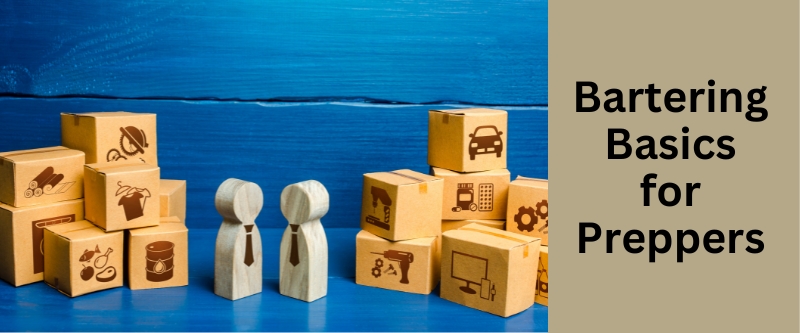Table of Contents
Staying Put Is Almost Always Your Best Bet
The Allure and Pitfalls of Bugging Out
Ah, the siren call of “bugging out”—it’s like the action movie of the prepping world, isn’t it? You’ve got your bug-out bag packed, your route meticulously planned, and a destination that’s practically a fortress.
But there is a whole lot that can go wrong in this scenario. And the purpose of this post is to explain why bugging out could be a disastrous decision.
We’ll explore why “bugging in” or sheltering-in-place is likely a more viable and safer option. So grab a cup of coffee, or perhaps something stronger (no judgment here), and let’s get into the nitty-gritty of why bugging out should be your last resort.
The Romanticized Notion of Bugging Out: Hollywood vs. Reality
Ah, Hollywood! The land of endless possibilities, where bugging out is as glamorous as a James Bond movie. You’ve seen the films—rugged heroes and heroines, armed to the teeth, effortlessly navigating through apocalyptic landscapes. But let’s hit the pause button and ask: Is this celluloid dream anywhere close to reality? Spoiler alert: Not really.
The Hollywood Narrative
In movies, our protagonists often have unlimited resources, impeccable timing, and a knack for dodging bullets—literally. They make it look so easy, don’t they? But here’s the kicker: real-life is not a movie set, and you’re not the invincible hero. In reality, bugging out is fraught with risks and challenges that most films conveniently gloss over.
The Real Risks of Bugging Out
Bugging out exposes you to a plethora of risks, including but not limited to:
- Exposure to Elements: Mother Nature is not always kind. Extreme weather can turn your bug-out journey into a life-threatening ordeal.
- Security Risks: The world is not a friendly place during a crisis. From looters to hostile groups, the threats are real and ever-present. And it’s not just you at risk. How about the family.
- Resource Scarcity: Contrary to the Hollywood depiction, you won’t find conveniently placed caches of supplies along your route. Resource scarcity is a genuine concern.
- Economic and emotional loss: You are abandoning your home and who knows what will happen to it in your absence. You face a high likelihood of returning to find it stripped bare by looters or occupied by squatters.
The SHTF Scenario: When the Shit Hits The Fan
tion might be compromised, your supplies could run out, and let’s not even talk about the potential for injury or illness. The point is, when the chips are down, bugging out could very well add to your problems rather than solve them.
Do not romanticize the idea of bugging out. Bugging out poses serious risks and challenges that you need to think through.
The Bug-In Strategy: Your Home as a Fortress
Do not lightly abandon the comforts of home! There’s no place like it, especially when the world outside is unraveling at the seams. But can your humble abode also double up as a fortress in times of crisis? You betcha!
Why Home Defense Trumps Bugging Out
Let’s get real for a second. Your home is not just a building; it’s a treasure trove of resources and, most importantly, it’s familiar territory. You know the nooks and crannies, the strengths and vulnerabilities, which is a significant advantage. Here’s why:
- Resource Availability: From food storage to medical supplies, your home is likely stocked with essentials.
- Community Support: Neighbors can be a valuable resource. A community can pool resources, share skills, and provide emotional support.
- Strategic Advantage: Knowing your terrain gives you a home-field advantage, making it easier to set up security measures.
- Four Solid Walls: A home is a defensible position. A tent by the side of the road is not.
The Essentials of a Bug-In Strategy
So, if bugging in is the way to go, how to go about it? Here’s a quick rundown:
- Stock Up: Ensure you have enough supplies to last for an extended period. Think food, water, medicine, and yes, even toilet paper.
- Fortify: Reinforce doors, windows, and other potential entry points. Consider setting up surveillance systems.
Plan: Have an emergency plan in place. Who does what, when, and how? Drill these plans regularly.
See this Ultimate Prepper Checklist.
Crisis Management: Keeping Your Cool When Things Go South
When the best-laid plans go awry, crisis management skills come into play. You have to adapt, improvise, and overcome challenges. Whether it’s a natural disaster or a man-made catastrophe, keeping your wits about you can make all the difference.
But the point is that it is much easier to manage a crisis when you are at home base than when you are bugged out and on the road. It might seem uncomfortable but it can make more sense to stay hopping around in the frying pan rather than jumping out into the fire. In other words, it’s a lot more comfortable than being on the road.
So, there you have it. Your home is more than just a shelter; it’s your first line of defense. And with a little preparation and a lot of common sense, it can be your sanctuary in times of crisis.
The Ultimate Bug-In Strategy
Here is the ultimate bug-in strategy: Get bugged out already! This will be the subject of a different post but it is worth making the point here.
What we mean is that, with the way the world is going, it may be smart to move to where you would want to bug out in advance.
There is no denying that there seems to be something in the air. People are beginning to flee the big cities. People are already taking advantage of increasing opportunities to work from home.
So there is a great deal to be said for moving to a really tenable bug out location and making it home well in advance of any SHTF scenario. In fact, it is the ultimate insurance policy.
After all, nobody bugs out to go nowhere. There is always a bug-in location in mind. That is, unless you are a died-in-the-wool survivalist.
The Psychology of Bugging Out: Why It’s a Common Go-To
Ah, the human mind—a fascinating labyrinth of thoughts, emotions, and impulses. But when it comes to bugging out, what is it that makes this option so tantalizing for many?
The Illusion of Control
There seems to be something empowering about the idea of taking matters into one’s own hands, hitting the road, and facing the unknown. It gives one a sense of being in control. But here’s the rub: this control is often an illusion. The variables in a bug-out scenario are numerous and unpredictable – in fact, beyond control.
The Adventure Factor: The Thrill and the Peril
Let’s not kid ourselves; there’s a certain thrill in the idea of bugging out. It’s an adventure, a challenge to your survival skills. But remember, adventures come with risks—sometimes life-threatening ones. The line between adventure and peril is razor-thin.
FOMO: The Fear of Missing Out
Ah, FOMO, that nagging feeling that everyone else is doing something exciting and you’re missing out. In the context of bugging out, FOMO can manifest as the fear of missing out on a “safe haven” or a “better situation.” But as we’ve discussed, the grass isn’t always greener on the other side.
The Role of Social Media and Peer Pressure
In this age of social media, everyone’s an expert, aren’t they? Your feed is probably filled with posts about the “perfect” bug-out bag or the “ideal” bug-out location. But don’t be taken in. Bug-out hype can distort perception and lead to impulsive decisions.
So, before you give in to the psychological allure of bugging out, take a step back. Weigh your options, assess the risks, and be honest with yourself. Are you choosing to bug out for the right reasons, or are you falling prey to psychological traps?
The Logistics of Bugging Out: It’s Complicated, Folks!
Ah, logistics—the unglamorous, nitty-gritty details that can make or break your bug-out plans. You might have the spirit of Bear Grylls and the wisdom of Yoda, but without proper planning, you’re setting yourself up for failure. Let’s dive into the logistical labyrinth, shall we?
The Bug-Out Bag: Not a Magic Satchel
You’ve seen those lists, right? The “101 items you absolutely must have in your bug-out bag.” But let’s get real. Your bug-out bag isn’t Mary Poppins’ carpet bag; it has limits. Overpacking can lead to fatigue, while underpacking can leave you vulnerable.
- Essential Items: Focus on the basics—food, water, first aid, and shelter.
- Weight Considerations: Balance is key. Your bag should be heavy enough to include essentials but light enough to carry for extended periods.
The Route: It’s Not a Sunday Drive
Choosing a bug-out route is not as simple as firing up Google Maps and hitting the road. You need to consider multiple factors:
- Terrain: Is it passable by foot or vehicle?
- Safety: Are there potential hotspots for criminal activity? Remember that desperate people, who may be on the road with you, can turn criminal. They may just take your stuff from you.
- Alternate Routes: Always have a Plan B, and if you’re thorough, a Plan C and D.
Transportation: Your Trusty Steed
Whether it’s your SUV, a bicycle, or your own two feet, your mode of transportation is crucial. Each has its pros and cons:
- Vehicle: Faster but requires fuel and can break down.
- Bicycle: Silent and fuel-free but limited carrying capacity.
- Foot: Ultimate stealth but physically demanding.
Timing: The Golden Hour
In emergency situations, timing is everything. Knowing when to bug out is just as important as knowing how. Wait too long, and you risk getting caught in the chaos. Act too soon, and you might be jumping the gun.
So, there you have it—the logistics of bugging out are a complex web of decisions and trade-offs. It’s not a journey to be undertaken lightly or without thorough preparation. Trust me, folks, you don’t want to learn these lessons the hard way.
And we keep coming back to family. It’s one thing to strike out on your own or with a single adult companion. It is quite another if you have children or elderly relatives with you.
The Legal and Ethical Implications: Navigating the Gray Areas
Ah, the law—a tangled web of rules and regulations that most of us would rather not think about, especially when it comes to survival. But even in times of crisis, legal and ethical considerations can’t be tossed out the window.
Legal Restrictions: You Can’t Just Do What You Want
In a crisis, certain areas may be restricted for public safety. Ignoring these restrictions can result in legal consequences. And let’s be honest, the last thing you need in a survival situation is to be on the wrong side of the law.
- Curfews: Often imposed to maintain public order.
- Restricted Zones: Could be due to ongoing rescue operations or hazardous conditions.
- Property Laws: You can’t just set up camp wherever you please.
Remember, when it comes to the law, you are always on stronger ground at home, especially when it comes to armed self-defence.
Also, bear in mind that, in a hair-on-fire SHTF scenario, people enforcing the law are spread thin and under high stress. You do not want to be on the receiving end of heavy handed and even panicked law enforcement
Ethical Dilemmas: The Tough Choices
Even in a crisis, the social contract—that unwritten agreement that holds society together—still applies. Besides, cooperation and mutual aid can go a long way in ensuring collective survival.
So, before you decide to go all “lone wolf” and bug out, consider the legal and ethical implications. Your actions have consequences, and in a crisis, those consequences can be magnified tenfold. It’s not just about survival; it’s about surviving the right way.
This is not at all to suggest that you roll over and give away all your stuff to make yourself feel good. But rather take time in your preparation for potential disaster to involve like minded neighbors in sharing resources and bug-in strategies. In this way everyone is stronger if SHTF happens.
Evaluating Your Bug-Out Location: Is It Worth It?
First, some perspective. Bugging out with no idea of your bug out destinationi s insane. What are you thinking?
So you need to know where your bug-out hideout is. And its location can significantly impact your chances of survival. So, what makes a bug out location suitable?.
Factors to Consider
- Accessibility: Is the location easily reachable by foot or vehicle? Consider how far you’ll need to travel and the potential obstacles along the way.
- Resources: Assess the availability of essential resources such as water, food sources, and shelter materials.
- Security: Evaluate the safety of the area from both human and environmental threats. Is it prone to natural disasters or close to potential conflict zones?
- Community: Are there any nearby communities that can offer support? A secluded bug-out location might provide isolation, but being part of a community can provide mutual aid and shared resources.
Site Visits
- Physical Inspection: Whenever possible, visit potential bug-out locations in person. Walk the terrain, assess the surroundings, and get a firsthand feel of the area.
- Test Runs: Conduct practice runs to the location to understand travel times, obstacles, and potential challenges.
- Adaptability: Consider how well the location can adapt to changing circumstances. Will it remain viable in different seasons or scenarios?
Control
- Is this location yours? Do you own it? Will it shelter you?
- Gut Check: Is it really going to be better than where you are now? Especially considering the risks in getting there.
Bug-Out Training: Practice Makes Perfect
No matter how well-stocked your bug-out bag is, your chances of survival increase exponentially with proper training. So, let’s look at the importance of acquiring and honing essential survival skills.
Survival Skills to Acquire
- Fire-Starting: Master various methods of starting fires, as fire is crucial for warmth, cooking, and signaling.
- Shelter Building: Learn to construct effective shelters using natural materials or basic gear.
- Navigation: Develop navigation skills using compasses, maps, and natural landmarks.
- First Aid: Acquire basic medical skills to address injuries, illnesses, and emergencies.
- Water Sourcing and Purification: Learn how to find and purify water from various sources.
Regular Practice
- Scenario Drills: Simulate survival scenarios to practice decision-making, resource management, and adapting to changing conditions.
- Outdoor Experience: Spend time outdoors to become familiar with nature’s rhythms, weather patterns, and survival challenges.
- Courses and Workshops: Participate in survival courses and workshops to learn from experts and gain hands-on experience.
Gut check: are you ready to dig in and acquire all these skills? Do you have the time? Would you be better off preparing where you are, so that you can stay bugged-in?
The Gray Zone: When Bugging Out Makes Sense
When to Bug Out
- Imminent Natural Disasters: Hurricanes, floods, and wildfires might necessitate evacuation to ensure safety.
- Immediate Threats: If your location is compromised by hostile forces, such as during civil unrest, bugging out could be the best course of action.
Bug-Out Plan Indicators
- Trigger Points: Define specific trigger points that indicate when it’s time to bug out. For instance, a rapidly approaching wildfire or a deteriorating security situation.
- Communication: Establish a communication plan to stay informed about external developments and changing circumstances.
Bug-Out Essentials: What to Pack in Your Bug-Out Bag
Your bug-out bag is your lifeline in a crisis, containing essential items that can make the difference between survival and struggle. Here we’ll cover the key items you should include in your bug-out bag and provide insights into prioritizing space and weight. Please see the checklists here, where we discuss two types of bug-out bag, the Trek Bag and the Auto Bag.
Must-Have Essentials
- Food and Water: Pack lightweight, non-perishable food items and water purification methods to sustain you during your journey.
- Shelter and Clothing: Include a compact emergency shelter, sleeping bag, and weather-appropriate clothing to stay warm and dry.
- First Aid Kit: Pack a comprehensive first aid kit with essential medical supplies for treating injuries and illnesses.
- Navigation Tools: Carry a reliable compass, map, and GPS device to ensure you can find your way to your bug-out location.
- Fire-Making Supplies: Include waterproof matches, a lighter, and fire-starting tools to provide warmth and cook food.
- Multi-Tool: A versatile multi-tool can help with tasks ranging from building shelter to preparing food.
Weight Considerations
- Pare Down: While it’s tempting to pack everything, focus on essentials to keep your bag’s weight manageable.
- Multipurpose Items: Opt for items that serve multiple functions, reducing the number of items you need to carry.
- Prioritize: Think critically about each item’s necessity and potential usefulness.
- Two types of bag: The Trek Bag and the Auto-Bag come into play.
Communication Strategies: Staying Informed and Connected
In a crisis it is important to stay informed about the situation and stay connected with family. This section explores communication strategies to ensure you’re not isolated during challenging times.
Preparing Your Communication Plan
- Emergency Contacts: Create a list of emergency contacts, including family members, friends, and local authorities.
- Communication Devices: Include a fully charged cellphone with backup power sources, such as portable chargers and solar chargers.
- Two-Way Radios: Consider using two-way radios for short-range communication within your group.
- Alternative Communication: Learn Morse code or other signaling methods for situations where traditional communication methods fail.
Staying Informed
- Emergency Alerts: Enable emergency alerts on your devices to receive real-time information about local disasters and threats.
- Radio: Include a battery-powered or hand-crank emergency radio to stay updated on news and developments.
Building Resilience: Mental and Emotional Preparedness
Survival is as much about mental resilience as it is about physical strength.. So here are some things to consider when it comes to mental and emotional preparedness for the challenges of a bug-out scenario.
Developing Mental Toughness
- Stay Positive: Cultivate a positive mindset that focuses on solutions rather than dwelling on challenges.
- Adaptability: Train yourself to adapt to changing circumstances and make quick decisions under pressure.
- Stress Management: Practice stress-relief techniques such as deep breathing, meditation, and visualization.
Strengthening Emotional Resilience
- Support Network: Maintain social connections and rely on your community for emotional support.
- Self-Care: Prioritize self-care activities that help you relax and recharge, even in high-stress situations.
- Prayer: Nothing wrong with prayer.
Long-Term Survival: Planning Beyond the Initial Crisis
While bugging out might be necessary in the short term, it’s essential to consider your long-term survival plans. This section explores strategies to ensure your well-being beyond the initial crisis and how to transition from emergency mode to sustainable living.
This actually brings us back to our earlier comment about already being bugged out.
Establishing a Long-Term Strategy
- Sustainable Supplies: Think beyond short-term rations and focus on building a sustainable food source, such as gardening or raising livestock.
- Water Procurement: Explore options for purifying and storing water for extended periods.
- Skill Acquisition: Learn essential skills like farming, animal husbandry, and basic construction.
Building a Self-Sufficient Lifestyle
- Off-Grid Living: Consider alternatives to traditional utilities, such as solar panels for electricity and rainwater harvesting.
- Community Building: Collaborate with like-minded individuals to create a self-sustaining community that shares resources and skills.
Bugging Out: The Last Resort
So, there you have it, folks—the unvarnished truth about bugging out. It’s not the action-packed adventure Hollywood would have you believe, nor is it the ultimate solution to all your survival woes. In fact, as we’ve explored, it’s fraught with risks, challenges, and complexities.
The Last Resort
The key takeaway? Bugging out should be your last resort. Your home, with all its familiar comforts and resources, is likely your best bet for survival. And even if you do decide to bug out, it should be a well-thought-out, meticulously planned move, not a knee-jerk reaction to a crisis.
Bugging out can be a viable option in certain situations. In fact, in some cases it may be the only option. But you should weigh it against the risks and challenges that go with it. The safety and well-being of your loved ones will be your top priorities.
For example, bugging out and bugging out fast makes perfect sense in a hurricane scenario. If your home is near the coast and on low lying ground, you would be nuts not to bug out. But in this case, you have the expectation of returning home once the danger is past.
Decision Making
Before you make a decision, evaluate your circumstances, resources, and capabilities. This includes the capabilities of your family. Are they seriously up to the challenges of bugging out?
Consider the nature of the crisis, your location, and the availability of resources. Make sure you have the knowledge, skills, and supplies needed for your specific situation.
Whether you choose to bug in, bug out, or adopt a combination of both strategies, always prioritize safety, preparedness, and adaptability.
And here is the main takeaway. The next time you find yourself romanticizing the idea of bugging out, take a step back and think it through. Your life—and the lives of those you care about—could depend on it.





Leave a Reply